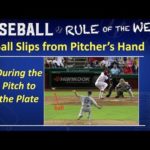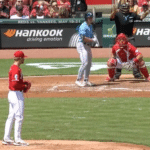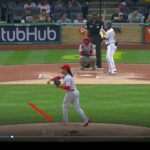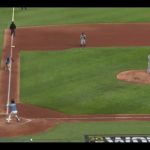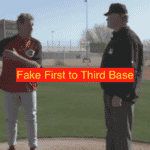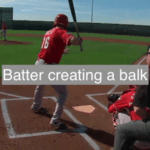BALK REGULATIONS
Rule 6.02(a):
A balk shall be called audibly (“Balk!” or “That’s a balk!”) and by pointing laterally at the pitcher. However, the ball is not dead automatically when this call is made. The ball becomes dead only when the umpire calls “Time” following the call of balk, and the call of “Time” is to be made only when play stops (i.e., when it is apparent that all runners including the batter-runner will not advance one base).
REGULATIONS:
(a) The pitcher shall be charged with a balk if, while in contact with the rubber, he throws to a fielder who is either in front of or behind first or third base and obviously not making an attempt at retiring the runner at that base. However, there is no violation if the pitcher throws the ball directly to first or third base in this situation. (Also see next paragraph in this section.)
(b) There is no violation if a pitcher attempts a legal pickoff at second base and, seeing no fielder covering the bag, throws to a fielder, who is neither in the vicinity of the bag nor making an actual attempt to retire the runner.
(c) When a pitcher swings any part of his free foot past the back edge of the pitcher’s rubber, it is a balk if he does not pitch to the batter, unless he throws (or feints a throw) to second base on a pickoff play. (Note that this violation is in reference only to the pitcher’s foot. If the knee of the pitcher’s free leg passes behind the back edge of the rubber but his foot does not, he may legally throw to first base with no violation.)
Items (d) through (i) below deal with step balks:
(d) Official Baseball Rule 6.02(a)(3) requires the pitcher, while touching the pitcher’s plate, to step directly toward a base before throwing to that base. If a pitcher turns or spins off of his free foot without actually stepping, or if he turns his body and throws before stepping, it is a balk.
NOTE: The pitcher is required to step directly toward a base when feinting a throw to a base. (Under current rules, the only base a pitcher may feint to is second.) Umpires should indicate balks called under Official Baseball Rule 6.02(a)(3) (no step) by slapping the side of their leg after calling the balk. This indicates the balk is for failure to step directly towards a base.
(e) A manager, coach, or player may not come onto the field or leave his position to protest the call of a balk as defined in Official Baseball Rule 6.02(a)(3) (failure to step directly towards a base before throwing there). If such protest is made, the manager, coach, or player shall be ejected from the game.
(f) A manager may come out and question the reason for a balk call (other than a step balk) and shall not be ejected for his visit to learn why the balk was called. The manager may be ejected if he argues the call after explanation.
(g) If a pitcher, while touching the pitcher’s plate, jumps into the air with both feet simultaneously and his non-pivot foot lands in a step towards first base before he throws to that base, he has made a legal move.
(h) Under the changes made to the Official Baseball Rules for 2013, the pitcher, while in contact with the rubber, may no longer fake a throw to third base (in addition to not being allowed to fake to first base). This rule change outlaws the so-called “Third-to-First Move.”
The pitcher is still allowed to fake a throw to second base while in contact with the rubber provided that he steps towards second.
Note that a pitcher, when faking a throw to second base, is not required to have arm motion in the fake, although a legal step is required.
The pitcher, of course, may properly disengage the rubber and then fake to any base. The pitcher is considered an infielder after he properly disengages the rubber. See Official Baseball Rule 6.02(a)(2) and the Comments to Official Baseball Rule 6.02(a)(3).
(i) It is legal for a right-handed pitcher to begin a pickoff move to first base by first moving his pivot foot in the direction of third base provided that he makes a legal step toward first base with the non-pivot foot before throwing there and provided that the move is continuous and without interruption. A pitcher who makes such a pickoff move is considered to be in contact with the rubber when he makes his throw to first base.
(j) When using the set position with runners on base, a pitcher must come to a complete stop with his front foot on the ground.
(k) It is a balk if the pitcher, while touching the pitching rubber, accidentally or intentionally drops the ball or if the ball slips or falls out of his hand or glove. However, a pitched ball that slips out of the pitcher’s hand and crosses the foul line shall be called a ball; otherwise it will be called no pitch. If the ball does not cross the foul line, this would be a balk with men on base.
(l) If the pitcher steps off the rubber with his non-pivot foot when pitching from the windup position, the pitcher shall be charged with a balk.
(m) If the pitcher places the resin bag in his glove with, in the umpire’s judgment, the intent of deceiving the runner, it is a balk.
(n) Prior to assuming a legal pitching position (windup or set position) it is permissible for the pitcher to momentarily adjust the ball in his glove. In order for this to be allowed, the movement must be momentary in nature. If the pitcher has his hands together long enough that, in the judgment of the umpire, it appears that he has actually come to a set position or has actually assumed the windup position, then should the pitcher separate his hands, a balk shall be called under Official Baseball Rule 6.02(a)(10).
(o) After coming to a legal pitching position (windup or set), if the pitcher removes one hand from the ball other than in an actual pitch or in throwing to a base, it is a balk.
(p) Under Official Baseball Rule 6.01(g), if a runner is stealing home when the catcher interferes with the batter, an additional penalty of a balk is invoked which enables all runners on base to advance (whether or not they were stealing).

